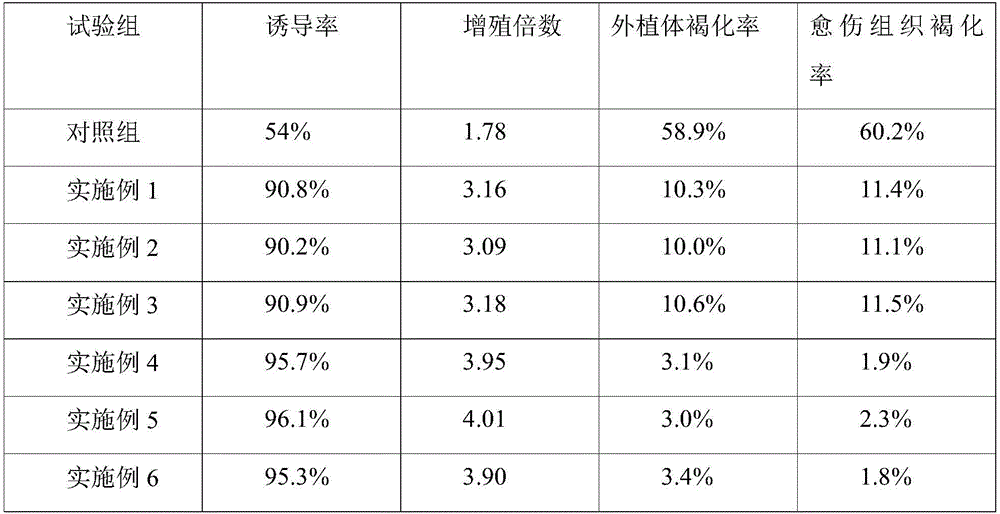High-efficiency induction method of Corydalis saxicola Bunting calluses
A technology for callus and Coptis chinensis, which is applied in the field of efficient callus induction of Coptidis chinensis, can solve problems such as the difficulty of large-scale propagation of wild Coptidis chinensis, and achieves the effects of solving difficulties in large-scale propagation, efficiently inducing, and accelerating the induction process.
- Summary
- Abstract
- Description
- Claims
- Application Information
AI Technical Summary
Problems solved by technology
Method used
Image
Examples
Embodiment 1
[0021] (1) Selection and disinfection of explants: take the leaves of Litectinus chinensis as explants, soak them in 2% aqueous solution of detergent for 5 minutes, wash them in linear tap water for 5 minutes, disinfect the surface in 75% ethanol for 45 seconds, and then use 0.1% HgCl 2 Disinfect for 9 minutes, rinse with sterile water for 5 times, and finally absorb surface moisture with sterile filter paper to obtain leaf explants;
[0022] (2) Explants are induced to obtain callus: the leaf explants obtained in step (1) are inoculated into the induction medium for cultivation, and the induction medium is based on B5 medium as the basic medium, and the hormone 6-benzyl is also added Base adenine 1.1mg / L, 2,4-dichlorophenoxyacetic acid 1mg / L, VC20mg / L, activated carbon 0.2g / L, sucrose 30g / L and agar 4.5g / L, adjust the pH value of the induction medium 6.0, the culture temperature is 25°C, and the leaf explants are cultured in the dark for 1 week before being cultured in the li...
Embodiment 2
[0025] (1) Selection and disinfection of explants: Take the petiole of Litectinus chinensis as explants, soak in 2% aqueous solution of detergent for 10 minutes, rinse in linear tap water for 15 minutes, disinfect the surface in 75% ethanol for 30 seconds, and 0.1% HgCl 2 Disinfect for 8 minutes, rinse with sterile water for 3 times, and finally absorb the surface moisture with sterile filter paper to obtain petiole explants;
[0026] (2) Explant induction to obtain callus: inoculate the petiole explant obtained in step (1) into the induction medium and cultivate it. The induction medium is based on B5 medium as the basic medium, and the hormone 6-benzyl is also added. Base adenine 1.5mg / L, 2,4-dichlorophenoxyacetic acid 1.5mg / L, VC5mg / L, activated carbon 0.3g / L, sucrose 20g / L and agar 3.8g / L, adjust the pH value of the induction medium 6.0, the culture temperature is 23°C, the petiole explants are first cultured in the dark for 1 week and then light cultured, the light intens...
Embodiment 3
[0029] (1) Selection and disinfection of explants: take the stems of Litectinus chinensis as explants, soak in 2% aqueous solution of detergent for 7 minutes, rinse with linear tap water for 10 minutes, disinfect the surface in 75% ethanol for 40 seconds, and use 0.1% HgCl 2 Sterilize for 10 minutes, rinse with sterile water for 4 times, and finally absorb the surface moisture with sterile filter paper to obtain stem explants;
[0030] (2) Explant induction to obtain callus: the stem explant obtained in step (1) is inoculated into the induction medium for cultivation, and the induction medium is based on B5 medium as the basic medium, and hormone 6-benzyl is also added Base adenine 0.5mg / L, 2,4-dichlorophenoxyacetic acid 0.5mg / L, VC10mg / L, activated carbon 0.1g / L, sucrose 27g / L and agar 4.1g / L, adjust the pH value of the induction medium 6.0, the culture temperature is 26°C, the stem explants are first cultured in the dark for 1 week and then light cultured, the light intensit...
PUM
 Login to View More
Login to View More Abstract
Description
Claims
Application Information
 Login to View More
Login to View More - R&D
- Intellectual Property
- Life Sciences
- Materials
- Tech Scout
- Unparalleled Data Quality
- Higher Quality Content
- 60% Fewer Hallucinations
Browse by: Latest US Patents, China's latest patents, Technical Efficacy Thesaurus, Application Domain, Technology Topic, Popular Technical Reports.
© 2025 PatSnap. All rights reserved.Legal|Privacy policy|Modern Slavery Act Transparency Statement|Sitemap|About US| Contact US: help@patsnap.com

